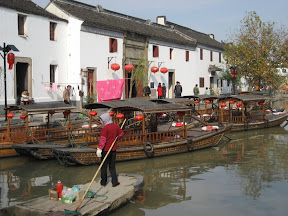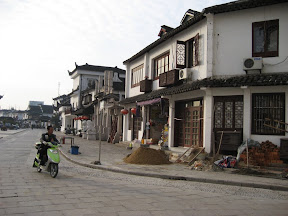ZhuJiaJiao
On Sunday, Jason insisted on traveling to the outskirts of Shanghai butt early in the morning to visit ZhuJiaJiao (‘The Zhu Family Township’), a small canal town that seems much like China’s version of Venice. Having barely seen Shanghai, I was more than a little bit overwhelmed! We arrived at 8:00 am and met up with three other friends, including Kelly, a young woman from Texas who is fluent in Mandarin and Japanese.
Kelly, being blond but ironically the much more well-spoken one, ended up ordering a breakfast of dou nai (hot sweet soymilk) and you tao (Chinese donut) for me. It was freezing cold outside so the five of us quickly lapped up the great variety of soymilks and soups we ordered at a little place near the parking lot around the corner from a KFC. Yes, KFC is everywhere, but Kentucky Fried Chicken is apparently better here than in the states. Someone expressed to me that KFC is so prevalent here that many Chinese think that it originated in China!
As ZhuJiaJiao was once a very important town when Nanjing was still the capital of China, the locals have made it a point to preserve the charming architecture and bridges that span the canals. They’ve obviously capitalized on the tourism business as well, but since it is smaller than Hanzhou or Suzhou, the town has maintained its authenticity. Still populated with locals, the town has a traditional style ‘mansion’, pharmacy, post office, and tea house that are maintained as living museums. As we made our way through the tight streets and past the always persistent street vendors, we also found locals washing their clothing on stone tablets and drying fruits and vegetables under the sunshine, as they did in the Ching dynasty.
ZhuJiaJiao reminded me of two themes:
The conflict of the new and the old: China has hundreds, if not thousands of years of design history. ZhuJiaJiao represented Chinese traditional design at its best. However, as it establishes its global presence, China is trying to shed its tradition in favor of the modern. How is China integrating tradition with technology? How is China integrating tradition with modernity, if not at all?
Brand differentiation in an informal network: Every fifth stall in ZhuJiaJiao was a silk blanket store. What was strange to me was that they were all selling the same brand of silk blankets. Same thing with the food vendors. Same thing with the balloon shooting game stalls. If one store or vendor proves to be successful, a dozen more will spring up beside it doing the exact same thing. So how does one choose which vendor to buy a silk blanket from? Maybe brand is represented by the seller rather than as an abstraction represented by a company logo. Maybe I choose to buy from one silk vendor vs. another because I was referred to her by a friend. Trust and word of mouth credibility is of utmost important here where companies have very little brand equity.
More photos here: http://picasaweb.google.com/shanghai.journey/ZHUJIAJIAODEC2



0 Comments:
Post a Comment
<< Home